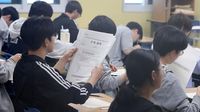On June 4, 2025, thousands of South Korean students sat for the 2026 academic year College Scholastic Ability Test (CSAT) June Mock Exam, a pivotal step in their university admissions journey. The Mathematics section, a critical component of the exam, was analyzed by leading educational institutions and found to be slightly easier than last year's actual CSAT, yet maintaining a comparable level of challenge overall.
Both MegaStudy Education and DaeSung Academy, two of the country's prominent education centers, concurred in their assessments that the Mathematics section was generally similar to or marginally less difficult than the 2025 CSAT. This was a relief to many, especially considering the notoriously difficult 2024 CSAT, often dubbed "불수능" or "the brutal CSAT," which had left students grappling with unprecedented challenges.
Breaking down the Mathematics section, MegaStudy noted that the common Mathematics subjects and the Calculus and Geometry components were slightly easier than last year’s exam. Meanwhile, Probability and Statistics and Geometry maintained a difficulty level close to that of the previous year. DaeSung Academy echoed this sentiment, stating that Probability and Statistics and Calculus and Geometry mirrored last year’s difficulty, while Geometry was somewhat easier.
However, not all questions were straightforward. DaeSung Academy highlighted problem number 15 from the common subjects, which required interpreting a given limit expression as a differential coefficient, as notably challenging. Additionally, problem number 22, drawn from the exponential and logarithmic functions unit of Mathematics I, was singled out. This unit had been infrequently tested in recent years, making this problem feel unfamiliar and tricky for students.
In the selective subjects, the Calculus and Geometry section posed some of the toughest questions. Problems 28 and 30 were identified as particularly demanding. Problem 28 required students to infer a function based on given conditions—a process that many might find unfamiliar. Problem 30 demanded a high level of reasoning and a deep understanding of differential concepts to interpret various conditions correctly. Jongro Academy, another key educational institution, noted that Calculus and Geometry were more difficult than last year's CSAT, especially highlighting problems 28, 29 (related to infinite geometric series), and 30 (which involved composite functions including absolute values) as very challenging.
Geometry questions, meanwhile, leaned heavily on the fundamental properties of shapes. This meant that students with a solid grasp of basic geometry found these problems manageable, while those less confident may have perceived them as more difficult.
Kim Won-joong, head of DaeSung Academy's admissions strategy office, advised students to focus their preparation on past exam questions and related textbooks. He emphasized the importance of deeply understanding the structure of recurring problem types and engaging in repetitive practice. "It is crucial to accurately grasp the fundamental concepts and develop the ability to apply them across various questions," Kim said. "Familiarity with question types and honing application skills through consistent practice will greatly benefit students."
Beyond Mathematics, the Korean language section of the exam was also closely scrutinized. MegaStudy Education and Jongro Academy generally agreed that the Korean section's difficulty was on par with last year's CSAT, which was considered moderate. However, some experts noted subtle variations in difficulty, with certain parts being slightly tougher.
MegaStudy Education reported a high linkage rate with EBS (Educational Broadcasting System) materials, a key resource for CSAT preparation. Specifically, three passages in the 'Reading' section (excluding reading theory) were all connected to EBS CSAT lectures, increasing the perceived relevance of the exam content. In the 'Literature' section, classical poems such as "Dongyuga," classical novels like "Kim Jin-ok Jeon," and modern poems including "Yeoksa" were heavily linked to EBS materials.
Despite this linkage, some questions proved challenging. Nam Yoon-gon, head of MegaStudy Education’s admissions strategy research center, noted that the 'Reading' social science passage was a topic-integrated text, differing from previous years. This novel format likely increased the cognitive load on students. He pointed out that questions 8, 12, and 18 required nuanced understanding and were potentially difficult to interpret. Notably, question 12, which compared "thermolysis" and "electrolysis," was widely regarded as tough by admissions experts.
Jongro Academy found the 'Literature' section relatively challenging, especially the modern novel part, which included works not linked to EBS. Lim Sung-ho, CEO of Jongro Academy, remarked, "While there were no specific killer questions, the problems were discriminating, meaning they effectively differentiated between students of varying abilities."
Overall, some analyses suggested the June Mock Exam was similar to or even easier than last year's CSAT. Kim Won-joong of DaeSung Academy summarized, "Compared to last year's CSAT and the June Mock Exam held last year, the 'Reading,' 'Literature,' and all selective subjects were either similar in difficulty or slightly easier. It appears the exam was overall a bit easier."
The Korean language section comprises common subjects, including 'Reading' and 'Literature,' and selective subjects where students choose between 'Speech and Writing' or 'Language and Media.' The Mathematics section consists of common subjects Mathematics I and II, with students selecting one from 'Probability and Statistics,' 'Calculus and Geometry,' or 'Geometry' for the selective part.
This nationwide mock exam was administered simultaneously at 2,119 high schools and 511 designated institutions across South Korea, beginning at 8:40 AM. It was supervised by the Korea Institute for Curriculum and Evaluation (KICE), the official CSAT administering body, ensuring standardized testing conditions.
As students and educators digest these results, the general consensus underscores the importance of mastering fundamental concepts and practicing a wide variety of problem types. With the CSAT looming, these mock exams offer invaluable insights into the exam’s trends, helping students tailor their study strategies to maximize their chances of success.

